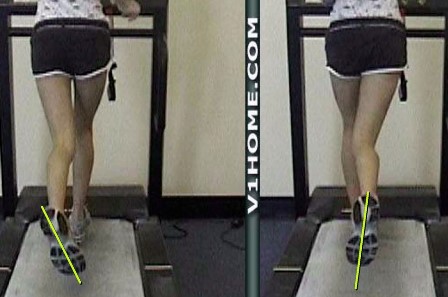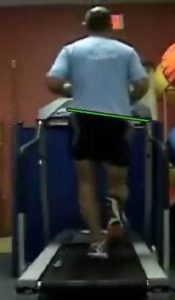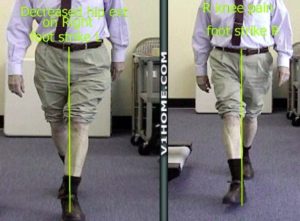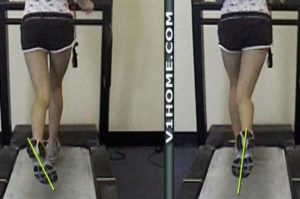It’s not hip to be in pain – Gait analysis & training can improve those pains in the backside

Are you experiencing pain in the lateral aspect (outer side) of your hips and/or buttocks when you walk or run? If so, using slow-motion video to identify gait deviations and working on your gait with a physical therapist can help solve the problem.
Gait deviations are movements that differ from the norm. A deviation can be considered positive or negative. For example, a gait deviation is considered negative if it causes pain when walking or running. But if your gait deviation – for instance, listing or leaning towards the side of a osteoarthritic hip – actually decreases the pain, then it’s considered a positive deviation.
The way you walk or run can contribute to the development of hip pain. Pain in the lateral hip/buttock region can be caused by bursitis, gluteal tendinopathy, piriformis syndrome, osteoarthritis or hip joint strain (such as a tear of the acetabular labrum).
Thorough diagnosis and treatment of such pain requires gait analysis and gait training. Research suggests that strengthening exercises alone -- without gait retraining -- will not alleviate gait deviations or the pain they might cause.
Conscious alteration of gait deviations is one of several possible interventions for painful conditions in the lower extremity.
Challenges and Considerations of Gait Analysis
Slow-motion video analysis is the best way to identify gait deviation. It requires observation of the belt line and the skin crease in the back of the knee as well as both sides of the body. The validity and reliability of video gait analysis is improved if the observed walking or running is fast enough or lasts long enough to produce gait deviation and/or pain.
Meaningful gait analysis should include secondary analysis where observed deviations are modified to see if there is an effect on pain. If you see something, do something.
Modifying movement has the potential to decrease, increase or alleviate pain altogether. If pain can be lessened or eliminated by conscious modification of walking and running form, that provides direction as to the most appropriate intervention.
If conscious modification of walking and running movement increases pain, it suggests that the gait deviation could be a subconscious positive compensatory modification.
Evidence
Evidence supporting use of the following options is based on previous clinical experience and peer-reviewed published research.
The working hypothesis for this model is as follows: If you show or see gait deviation when walking or running, a conscious effort to modify the deviation can alter the lateral hip/buttock pain.
Be sure to watch for side effects, unintended consequences of the intervention.
See Something? Do Something
- Excessive lateral pelvic drop: When viewed from behind, your belt line normally deviates from the horizontal by 4 percent. If the deviation is greater than 4 percent, you have excessive lateral pelvic drop, as illustrated in the image below.
- Imagine that your pelvis is a bucket of water. You must not let the water spill out the side when walking or running.
- Monitor and expect fatigue or muscle soreness in the lateral hip gluteal muscles.

- Foot crossing the midline of body: In the image below, on the left, the left foot is crossing the body’s midline.
- Consciously walk or run with a slightly wider foot strike. If you are on a road or track, using the side line as a guide will be more productive.
- Watch for and avoid overcorrection or a waddling gait with too much side-to-side motion. Expect muscle fatigue and soreness in the lateral hip/gluteal muscles.

- No knee window: When viewed from behind, you can see no daylight between the knees, as shown in the images below.

- Consciously keep daylight between your knees. Imagine wearing a thick diaper when walking or running.
- Monitor for overcorrection of waddling gait with too much side-to-side motion. Expect muscle fatigue and soreness in the lateral hip/buttock.
- Knee skin crease is oblique: When viewed from behind, the popliteal skin crease is oblique instead of horizontal, caused by excessive inward rotation of the hip/thigh. In the images below, the skin crease behind the knee in the left photo is oblique. In the right photo, it is horizontal, which is normal.

-
- Consciously engage gluteal muscles in stance phase, when your foot is in contact with the ground. Imagine the kneecap is a headlight pointing straight down the road. Walk on treadmill while visualizing that the kneecap is pointing straight ahead.
- Be careful to avoid excessive out-toeing or overcorrection and rotating or twisting from the pelvis and spine.
- Expect muscle fatigue, strain in the lateral hip and gluteal muscles.
- Kneecap “peeking” at the other kneecap: Your kneecaps should point straight down the road ahead rather than turning toward each other.
- Consciously engage the gluteal muscles. Imagine the kneecap is a headlight pointing straight down the road or walk on treadmill in front of a mirror, watching your kneecap.
- Monitor for overcorrection causing twisting in the spine and pelvis.
- Expect fatigue and soreness in the lateral hip and gluteal muscles.
- Excessive out-toeing: Viewing from behind, only two of your lateral toes should be visible. Being able to see more than two toes suggests excessive out-toeing.
- Consciously push the heel outward. Decrease out-toeing when walking or running by imagining your foot is the front tire on a car. Point it straight ahead.
- Monitor for increase in pain. If you have osteoarthritis of the hip, it is likely the excessive out-toeing is a gait deviation or compensation to avoid pain, and toeing in will increase pain. However, if you have had a total hip replacement, ongoing excessive out-toeing is a gait deviation compensation that is no longer needed; it should be altered.
- Excessive pronation: When you shift your weight off the heel as your foot strikes the ground, it can cause pain and problems with alignment.
- Consciously engage the intrinsic plantar flexor foot muscles during mid-stance while walking or running. Specifics are available by searching “short foot exercise” and “arch doming” on youtube.com.
- Monitor for toe pain, blisters or calluses. If any of these occur, you are using muscles other than the foot (calf muscles), and this is not correct modification.
More than one deviation? Keep it simple
Of the seven deviations described, it is likely that more than one deviation occurs at the same time. Choose only one to consciously modify. Keep it simple, stupid. On the plus side, it is likely that altering one will also alter adjacent gait deviations.
Conscious attempts to alter gait deviations can have a side effect of cognitive overload. It can be mentally fatiguing. It will feel weird. It can be frustrating.
It requires practice to change habits. With practice, your new or altered gait movement(s) should eventually “stick” and become the new normal.
Damien Howell Physical Therapy – 804-647-9499 – Fax: 866-879-8591 At-Home, At Office, At Fitness Facility – I come to you, I do home visits Damien@damienhowellpt.com
